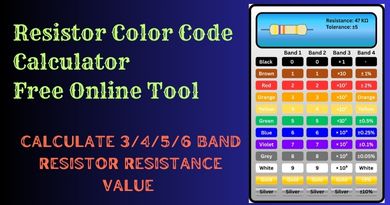Resistor Colour Code Calculator – Free Online Tool
Welcome to ElectroDuino’s Resistor Colour Code Calculator. This is a free, easy-to-use tool to quickly find the resistance value of 3-band, 4-band, 5-band, and 6-band resistors using their colour bands.
Try the Resistor Colour Code Calculator Now
Resistor Colour Code Calculator
Resistance: -
Tolerance: -
Temperature Coefficient: -
How to Use the Resistor Colour Code Calculator
Reading a resistor’s resistance values from the colour bands can be confusing and time-consuming, especially for beginners. Our Resistor Colour Code Calculator makes this process faster, accurate, and effortless.
Below is a comprehensive step-by-step guide to help you decode 3-band, 4-band, 5-band, and 6-band resistors using our online tool. Follow the step-by-step instructions below:
✅ Step 1: Examine the Resistor and Count the Bands
First, take a physical resistor in your hand and examine it carefully. Now count the number of coloured bands printed on the body of the resistor. You’ll typically find:
- 3 Colour Bands: Older or low-precision resistors (less common)
- 4 Colour Bands: Most commonly used standard fixed resistors (most common)
- 5 Colour Bands: Precision resistors with more accurate values (1% or better tolerance)
- 6 Colour Bands: High-precision resistors with temperature coefficient
📌 Tip: Hold the resistor in your hand so that the tolerance band (usually gold or silver) is on the right side. This ensures you’re reading the colour bands in the correct left-to-right order.
✅ Step 2: Select the Number of Bands in the Calculator
Once you’ve identified how many bands are present on your physical resistor, now come to the Calculator and select the appropriate band type from the dropdown menu:
👉 3-Band | 4-Band | 5-Band | 6-Band
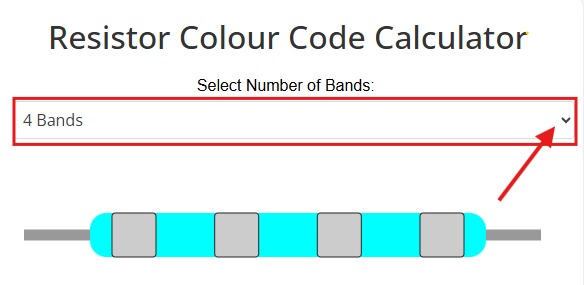
This step ensures the calculator displays the correct number of band selectors and applies the right logic for calculating the resistance value
✅ Step 3: Select the Colour for Each Band
For each resistor band (Band 1, Band 2, Multiplier, Tolerance, and Temp. Coefficient) has a dedicated colour selection column shown in the colour chart below the resistor graphic.
Simply click on the colour box that matches the band colour on your physical resistor. The colour code chart follows the standard resistor colour code — including Black, Brown, Red, Orange, Yellow, Green, Blue, Violet, Grey, White, Gold, and Silver.
Once you click a colour, a green border will highlight your selected colour in the chart. The corresponding band on the resistor graphic instantly updates automatically to reflect your selection.
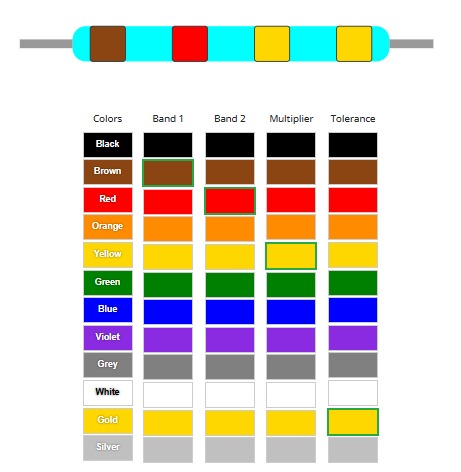
📌 Tip: You can change any band colour anytime just by clicking another colour box. If you select the wrong colour, simply click the correct one — the calculator updates instantly.
✅ Step 4: Read the Calculated Resistance Value
Once you’ve selected all the colour bands using the colour chart, the Resistor Colour Code calculator instantly displays the resistance value along with additional important details. This step gives you the final resistance value, tolerance, and temperature coefficient (For 6-band resistors only) of your physical resistor.
🔍 What You’ll See in the Output:

1. Resistance Value
You can see the calculated resistance value in the output section, which is measured in:
- Ohms (Ω)
- Kilo-ohms (kΩ)
- Mega-ohms (MΩ)
The value is formatted with proper units and SI notation, making it easy to read at a glance.
2. Tolerance Value (%) – Accuracy of the Resistor
Below the Resistance value, you can see the tolerance value. This defines how much the actual resistance value can vary from the labelled value of the resistor.
Expressed as a percentage (±%), based on the colour of the tolerance band.
✅ Common Tolerance Values:
- Gold = ±5%
- Silver = ±10%
- Brown = ±1%
- Red = ±2%
3. *Temperature Coefficient (For 6-band resistors only)
For 6-band resistors, an additional 6th band is used to show the temperature coefficient, usually measured in ppm/°C (Parts Per Million per Degree Celsius). This tells how the resistance changes as the temperature increases.
✅ Typical values:
- Brown = 100 ppm/°C
- Red = 50 ppm/°C
- Orange = 15 ppm/°C
What Is a Resistor Colour Code?
In electronics circuits, Resistors are the most common components that limit or control the flow of current. These resistors are available in different values, tolerances and temperature coefficients. Since printing numerical values directly on small resistors isn’t practical, manufacturers use standardised coloured bands to represent the resistor’s values and tolerance.
A resistor colour code is the IEC 60062 internationally standardised system of coloured bands printed on resistors to indicate their value, tolerance, and sometimes additional characteristics like temperature coefficient or reliability. This is used worldwide to ensure that even the resistor can be easily identified without needing printed numbers.
Each colour corresponds to a number (0–9), a multiplier, or a tolerance percentage. By reading these bands from left to right, you can determine the resistor’s exact value in ohms (Ω). The number of bands on a resistor can vary, based on the colour bands. The resistors are classified into 4 types, namely 3-band, 4-band, 5-band, and 6-band resistors.
Standard Resistor Colour Code Chat
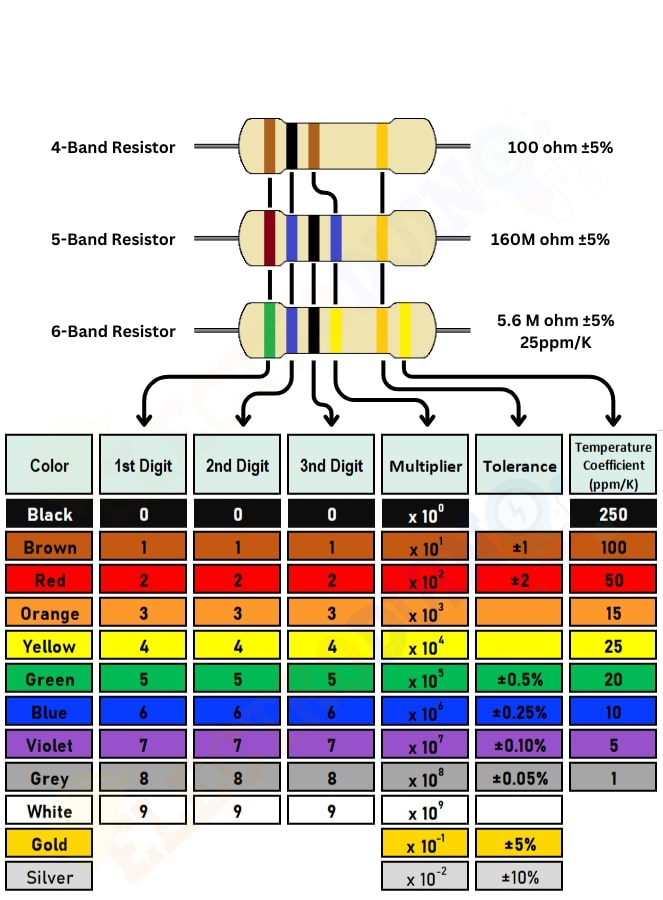
How This Resistor Colour Code Calculator Works
In the last section, we have learnt how to use the resistor colour code calculator. In this section, we’ll explain exactly what wonder happens after giving all the inputs to the calculator. It means how the calculator calculates the resistance value once you provide all the input (like selecting the number of bands and choosing the colours)
Once you’ve selected the number of bands and chosen the colour for each band from the calculator’s colour chart. Then it automatically maps each colour to its corresponding value using a predefined table based on the international resistor colour code standard.
After identifying the number of bands and the values for each band, the calculator applies the standard resistor colour code formula based on the number of bands selected:
4 Band Resistor Colour Code Formula
A 4-band resistor has 4 colour bands on it, each band has a specific purpose:
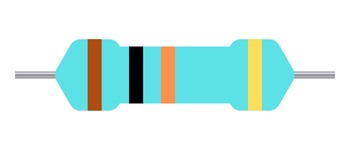
- Band 1: First significant digit
- Band 2: Second significant digit
- Band 3: Multiplier
- Band 4: Tolerance
Formula:
Resistance (Ω) = (First Digit × 10 + Second Digit) × Multiplier
Resistance Value and Tolerance Calculation:
- Band 1: Brown → 1
- Band 2: Black→ 0
- Band 3: Orange → × 1,000 (× 10³)
- Band 4: Gold → ±5%
Resistance value = (1 × 10 + 0) × 1000 = 10 × 1000 = 10,000 Ω = 10 KΩ
Tolerance = ±1%
5 Band Resistor Colour Code Formula
A 5-band resistor has 5 colour bands on it; these types of resistors are more precise than the 4-band type. Each band has a specific purpose:
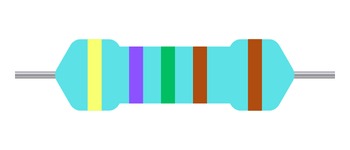
- Band 1: First significant digit
- Band 2: Second significant digit
- Band 3: Third significant digit
- Band 4: Multiplier
- Band 5: Tolerance
Formula:
Resistance (Ω) = (First Digit × 100 + Second Digit × 10 + Third Digit) × Multiplier
Resistance Value and Tolerance Calculation:
- Band 1: Yellow → 4
- Band 2: Violet → 7
- Band 3: Green → 5
- Band 4: Brown → ×10 (× 10¹)
- Band 5: Brown → ±1%
Resistance value = (4 × 100 + 7 × 10 + 5 ) × 10 = 475 × 10 = 4750 Ω = 4.75 KΩ
Tolerance = ±5%
6 Band Resistor Colour Code Formula
6-band resistors are high-precision components used in sensitive applications. These resistors include all the information of a 5-band resistor, including an extra band for temperature coefficient (ppm/°C) or reliability rating information.
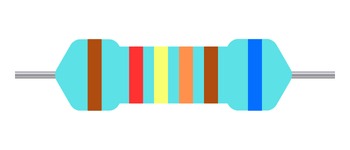
- Band 1 → First significant digit
- Band 2 → Second significant digit
- Band 3 → Third significant digit
- Band 4 → Multiplier
- Band 5 → Tolerance
- Band 6 → Temperature coefficient (ppm/°C)
Formula:
Resistance (Ω) = (First Digit × 100 + Second Digit × 10 + Third Digit) * Multiplier
Resistance Value, Tolerance and Temperature Coefficient Calculation:
- Band 1: Brown = 1
- Band 2: Red = 2
- Band 3: Yellow = 4
- Band 4: Orange = ×1000 (×10³)
- Band 5: Brown = ±1%
- Band 6: Blue = 10 ppm/°C (parts per million per degree Celsius)
Resistance Value = (1 × 100 + 2 × 10 +4) × 1000 = 124000 Ω = 124 KΩ
Tolerance = ±1%,
Temperature Coefficient = 10 ppm/°C
Features of Our Online Resistor Calculator
- ✅ Supports 3-band, 4-band, 5-band, and 6-band resistors
- ✅ Instant calculation of resistance, tolerance and Temperature Coefficient.
- ✅ Resistance values with automatic unit conversion (Ω, kΩ, MΩ).
- ✅ Mobile-friendly and works on all devices
- ✅ Free and easy to use — No Signup required

